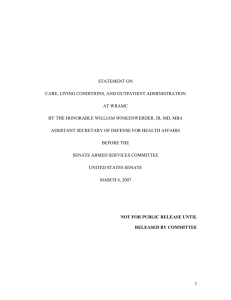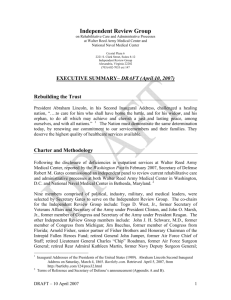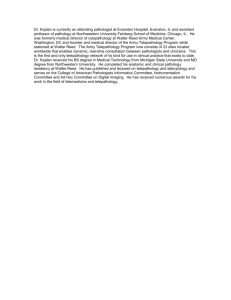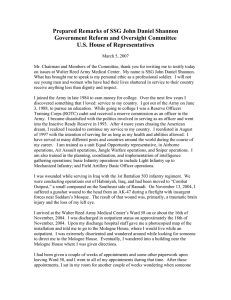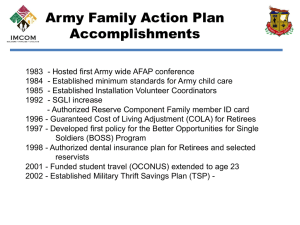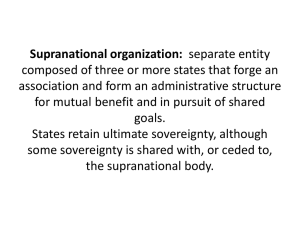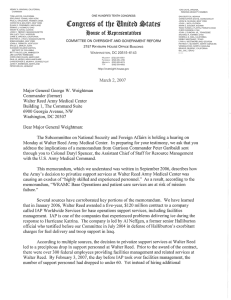STATEMENT ON CHALLENGES AND OBSTACLES WOUNDED AND INJURED
advertisement
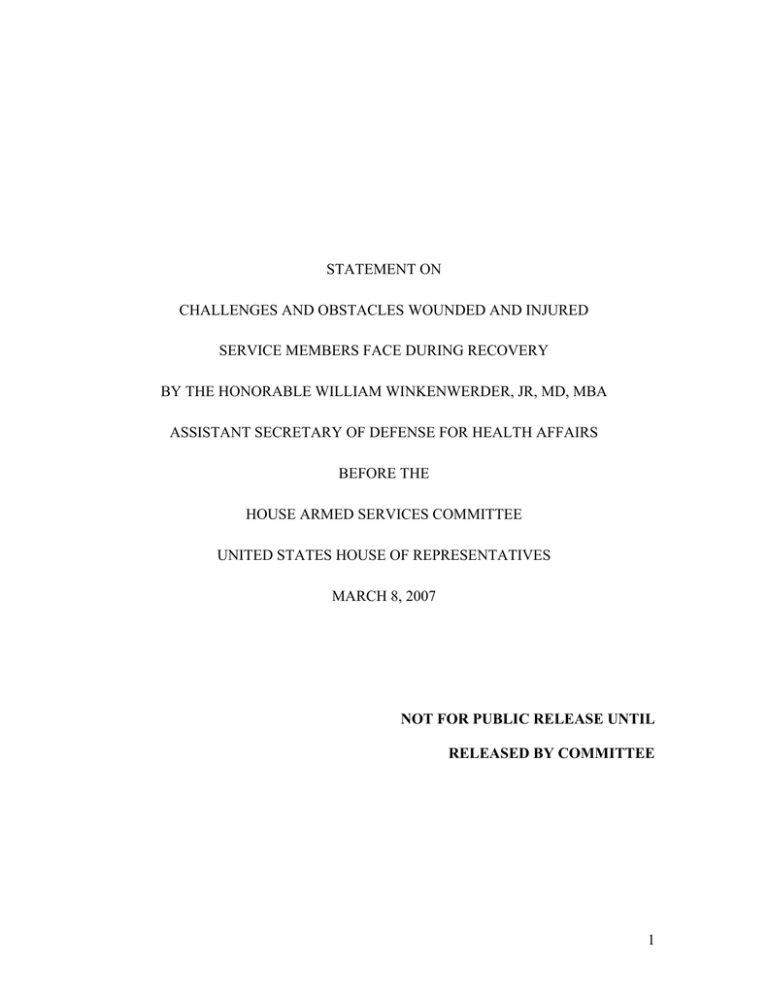
STATEMENT ON CHALLENGES AND OBSTACLES WOUNDED AND INJURED SERVICE MEMBERS FACE DURING RECOVERY BY THE HONORABLE WILLIAM WINKENWERDER, JR, MD, MBA ASSISTANT SECRETARY OF DEFENSE FOR HEALTH AFFAIRS BEFORE THE HOUSE ARMED SERVICES COMMITTEE UNITED STATES HOUSE OF REPRESENTATIVES MARCH 8, 2007 NOT FOR PUBLIC RELEASE UNTIL RELEASED BY COMMITTEE 1 Mr. Chairman, distinguished members of this committee, thank you for the opportunity to discuss the Military Health System, and in particular to address the concerns raised in recent news media reports regarding treatment of Service members at Walter Reed Army Medical Center. Our wounded Service members and their families deserve coordinated professional health care services – both clinical and administrative – together with quality housing and family member support. In the case of the incidents cited at Walter Reed, The Department did not meet our patients’ expectations, and we did not meet our own expectations. I want to address the events associated with the media reports and internal findings regarding substandard housing for some of the service members receiving outpatient, long-term rehabilitative care, and the administrative delays and hassles associated with the military’s disability process. I would first like to outline the principles that underlie the Department’s approach in addressing this problem. We welcome public scrutiny, even when it is critical. Perhaps especially when it is critical. In this case, the Department accepts the fundamental premise of the reports by the Washington Post that unacceptable conditions existed at Walter Reed for some of our service members. Where change is required, the Department will make it. The focus will be on understanding and fixing the problems using a systems approach. As Secretary Gates has stated, persons who allowed these conditions to persist will be held accountable. Yet, several of the issues identified cut across organizational boundaries, and our greatest attention will be to introduce change to the processes by which we support our service members and families. Our military health system is a unique, national asset. It must be preserved. As we engage on this issue using the skills and talents of our people to solve the problems, we must act carefully to preserve the morale and trust of our dedicated caregivers. Context Within the Larger Military Health System: Medical Support to Service Members We serve over 2.2 million members in the Active, Reserve, and Guard components, to include over 251 thousand service members deployed overseas, and another 7 million families, and retirees. Over 9 million Americans are entrusted to our care – and in both battlefield medicine and traditional health care delivery here at home, we are excelling in our mission. Based on data, measures, and independent assessments by health care organizations around the country, the performance of our military medical personnel on the battlefield and in our medical facilities in the United States has been extraordinary. We have established new standards in virtually every major category of wartime medicine, and many areas of peacetime medicine: 2 Lowest Disease, Non Battle Injury (DNBI) Rate. A testament to our medical readiness and preparedness, our preventive medicine approaches and our occupational health capabilities, we are successfully addressing the single largest contributor to loss of forces – disease. Lowest Death to Wounded Ratio. Our agility in reaching wounded service members, and capability in treating them, has altered our perspective on what constitutes timeliness in life-saving care from the “golden hour” to the “platinum fifteen minutes.” We are saving service members with grievous wounds that were likely not survivable even ten years ago. Reduced time to evacuation. We now expedite the evacuation of Service members following forward-deployed surgery to stateside definitive care Using airborne intensive care units and the latest technology, we have been able to move wounded service members from the battlefield to hospitals in the United States in as little as 48 hours. Our medical professional have provided high quality medical care, and indicators of quality compare very favorably with national benchmarks. The DoD Patient Safety Program is a national model, and efforts to reduce and eliminate medical errors have achieved ground breaking results. We are also ensuring our service members are assessed before deployments, upon return and then again 90-180 days after deployment. These health assessments provide a comprehensive picture of the fitness of our forces, and highlight areas where intervention is indicated. For example, we’ve learned that service members do not always recognize or voice health concerns at the time they return from deployment. By checking with them three to six months later, we’ve found that about half of them report physical concerns, such as back or joint pain, and a third of them have mental health concerns. As of January 31, 2007, 212,498 Service members have completed a post-deployment health reassessment with 31% of these individuals receiving at least one referral for additional evaluation. We have introduced an Individual Medical Readiness (IMR) measure that provides commanders with a picture of the medical readiness of their soldier, sailor, airman and marine down to the individual level. We have worked closely with our partners in the VA, in our shared commitment to provide our service members a seamless transition from the MHS to the Department of Veterans Affairs. DoD implemented a policy entitled “Expediting Veterans Benefits to Members with Serious Injuries and Illness,” which provides guidance on the collection and transmission of critical data elements for service members involved in a medical or physical evaluation board. DoD began electronically transmitting pertinent data to the VA in October 2005 and continues to provide monthly updates, allowing the VA to better project future workload and resource needs. Receiving this data directly from DoD before these service members separate eliminates potential delays in developing a claim 3 for benefits by ensuring that VA has all the necessary information to award all appropriate benefits and services at the earliest possible time. Here in the United States, our beneficiaries continue to give the TRICARE program high marks in satisfaction. Military health system beneficiaries’ overall satisfaction with medical care in the outpatient and inpatient settings compares very favorably against national civilian benchmarks. The quality of our medical care is further attested to by such organizations as the Joint Commission on Accreditation of Healthcare Organizations (JCAHO) that has recognized the excellence in our medical treatment facilities with ratings well above civilian averages. Internationally, our medical forces have deployed with great speed, skill and compassion. Their accomplishments in responding to international disasters has furthered our national security objectives; allowed us to constructively engage with a number of foreign nations; and saved civilian lives throughout the world. Operating on the global stage, our medics – from the youngest technicians to the most experience neurosurgeons – have performed in an exemplary manner in service to this country. We will make the necessary changes to our policies and processes, while remaining mindful of the skills, dedication, and courage of our medical forces. Identifying the Way Forward The set of issues addressed recently in the Washington Post deserve our immediate and focused attention. The Army and the Department have taken swift action to improve existing conditions, and enhance services provided at Walter Reed, and identify areas meriting further study and improvement. Army leadership initiated immediate steps to control security, improve access, and complete repairs at identified facilities and sought to hold accountable those personnel responsible to provide for the health and welfare of our nation’s heroes. Most recently, Secretary Gates commissioned an independent review group (IRG) on 1 March 2007 to evaluate and make recommendations on this matter. The IRG shall conduct its work and report its findings to the Secretary of the Army, the Secretary of the Navy, and the Assistant Secretary of Defense for Health Affairs NLT 16 April 2007. The Report will include: Findings of an assessment of current procedures involved in the rehabilitative care, administrative processes, and quality of life for injured and ill members, including analysis of what these heroes and their families consider essential for a high quality experience during recovery, rehabilitation and transition. Alternatives and recommendations, as appropriate to correct deficiencies and prevent them from occurring in the future. The Department will be relentless in its actions – engaged, action-oriented and focused on making measurable improvements. Goals will be clear and milestones will be established. We will regularly inform the people we serve – the soldiers, the families, 4 military leaders, the Congress, the Secretary and President -- on our progress. Findings and actions will be shared with the public. We know that this approach works. It has been successfully employed in attacking other issues over the past – the development and implementation of pre and post-deployment health assessments; clinical guidelines for psychiatric care; the development of stringent health information security measures and reporting processes; and the electronic collection of deployment health data. An Assessment of the Issues There are a number of disturbing elements to the conditions at Walter Reed, yet I am confident that each of these items is fixable with sustained leadership and oversight. The Department, with the assistance of the Secretary’s independent review group (IRG), will come forward with revised approaches to addressing the more complex personnel and medical issues. I would categorize and assess the problems before us as follows: Physical Facility Issues. In the case of substandard housing, the Army has been able to quickly implement a corrective action plan. Some of those actions have already occurred with facility repair and improvements. Clearly, other facility improvements may require more comprehensive repairs that may take longer. I am confident the Army and the Navy are taking steps to ensure that any needed improvements will be made. Process of Disability Determinations. The critical first step in assessing this process will be to identify the desired outcome. We know that there are expectations that both the service member and the Department want: Full rehabilitation of the service member to the greatest degree medically possible; A fair and consistent adjudication of disability; and A timely adjudication of disability requests – neither hurried nor slowed due to bureaucratic processes. The fundamental problems did not result from a lack of available resources.. The main effort here must be focused on the processes being analyzed and assessed for their value and alternatives. The processes must be redrawn with the outcomes we have in mind, with as much simplicity and timeliness as possible. Process of Care Coordination. Again, the quality of medical care delivered to our service members is exceptional. This assertion is supported by independent review. Yet, the process of coordinating delivery of services members in long-term outpatient, residential rehabilitation needs attention. The Army will assess, and my office will review, the proper ratio of case managers to wounded service members. The administrative and information systems in place to properly manage workload in support of the soldiers will also be assessed. 5 The planned consolidation of health services and facilities in the National Capital Region will enable the Department to best address the changing nature of inpatient and outpatient health care requirements, specifically the unique health needs of our wounded servicemembers and the needs of our population in this community. The BRAC decision also preserves a precious national asset by sustaining a high quality, world-class military medical center with a robust graduate medical education program in the Nation’s Capital. The plan is to open this facility by 2011. In the interim, we will not deprive Walter Reed of resources to function as the premier medical center it is. In fact, in 2005 we funded $10 million in capital improvements at Walter Reed’s Amputee Center – recognizing the immediate needs of our warrior population. We are proud of that investment in capacity and technology. We simply will not allow the plans for a new medical center to interfere with the ongoing facility improvements needed in the current hospital. The Legacy of Military Medicine Sustaining a medically ready military force and providing world-class health services for those injured and wounded in combat remains our primary mission. In the current spate of news reports on Walter Reed, the trust that we have earned through our other many medical achievements has been damaged. Everyone’s efforts will be focused on repairing and re-earning that trust. Our civilian and military leaders have remained steadfast in both their support of what we have accomplished, and their belief that these matters can be fixed. U.S. military medicine and our medical personnel are a national asset, representing a readiness capability that does not exist anywhere else, and – if allowed to dwindle – could not be easily reconstituted. We must preserve this asset. As the problems that lie at the intersection of personnel issues with health care delivery are addressed, it is our shared responsibility to focus on the specific problems, and not the people who have done so much to improve the health of our military service members. We are blessed with a rich cadre of dedicated, hard-working, skilled professionals. I have complete confidence that they will rise to the occasion again, as they have done in the past, learn from what went wrong, and build an even stronger, more responsive system for all. After more than five and one-half years of service as the Assistant Secretary of Defense for Health Affairs, I look forward to working together with you and with the leaders within the Services and DoD in the remaining weeks of my tenure to begin this effort at rebuilding this important part of our system that needs attention. And I remain grateful for the opportunity to have worked with such selfless servants that comprise the military health system. 6
